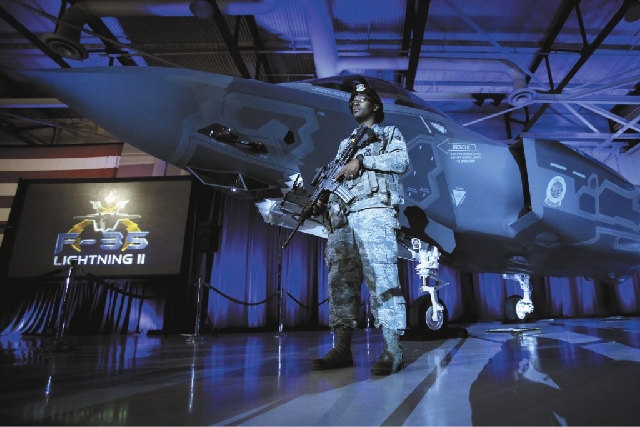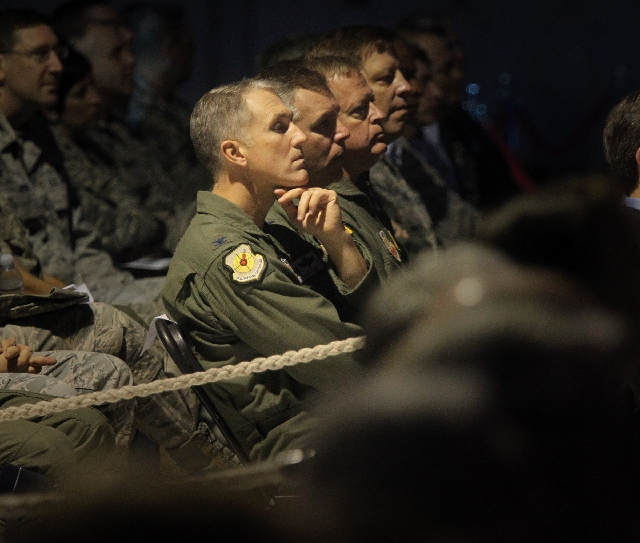F-35 arrivals celebrated at Nellis Air Force Base



There’s a new warbird on the block at Nellis Air Force Base.
The stealthy gray F-35 Lightning II joint strike fighter jet is meaner and more versatile than any in the aging fleets of F-16 Fighting Falcons and A-10 Thunderbolts that it will replace.
And the F-35 promises to be a fitting teammate for the nation’s next new warplane, the F-22 Raptor.
“The F-22, which will provide air superiority in the battle space, combined with the F-35 is a combination with no equal,” U.S. Air Force Warfare Center commander Maj. Gen. Jeffrey G. Lofgren said Tuesday to hundreds of airmen and community leaders gathered at the Thunderbirds hangar for the F-35 arrival ceremony.
Three of the $67 million jets landed at the base earlier this month, and a fourth was cleared to fly Tuesday from Lubbock, Texas, where it made a precautionary landing March 1. It was on its way to Nellis from Lockheed Martin’s production plant in Fort Worth, Texas.
“There was a wire connector issue in the flight control system, but the pilot was never in danger,” Lockheed spokesman Michael Rein said.
He said the plane has a triple redundant backup system for flight control. “We fixed it, powered up the airplane, and everything checked out.”
The plane had not arrived at Nellis late Tuesday.
Nellis is expected to have 36 Lightning IIs for testing and training by 2020.
After the ceremony, Lofgren said the task ahead is to make the aircraft combat ready.
“This is so complex and so advanced, there’s going to be huge amounts of information that we’re going to have to analyze to make sure we understand,” he said.
He said he doesn’t anticipate any problems with the plane’s oxygen system, which may have caused mysterious coughing and hypoxia-like symptoms in some F-22 Raptor pilots.
“I don’t see any of those problems,” Lofgren said. “Based on the amount of flying we’ve already done in the F-35 program, we’re not seeing anything like that occur with the F-35. So I have no worries.”
The Pentagon plans to acquire 2,443 F-35s. Some will go to at least eight partner nations: the United Kingdom, Italy, the Netherlands, Turkey, Australia, Norway, Denmark and Canada.
During the ceremony, Lofgren lauded the F-35’s prowess and described how it will work in tandem with the F-22’s air superiority.
“The way I think about this duo is the F-22 is stealth, plus super cruise, plus computer ability, plus integrated avionics, equals air dominance,” he said. “The F-35 is stealth, plus sensors, plus integrated avionics, equalling lethal and survivable strike capabilities.”
He spoke of the uncertain future of air combat as adversaries obtain advanced technology.
“We have, for probably the last 10-plus years, been pretty much uncontested in aerospace and cyberspace as we have practically focused on terrorism,” Lofgren said.
“However, if we look around the world and we see the developing threat capabilities from other countries, we realize we need to be prepared to fight back,” he said.
“Since we don’t know who we will get into a skirmish with, we do know that it’s likely they will have some of these emerging capabilities,” he said. “That is where the F-35 will come into play.”
Randy Black, honorary base commander and commander of Nellis Support Team, said the F-35 is a needed and welcome addition to the military and the Las Vegas community.
F-35s will account for 400 new jobs and $185 million in construction of beddown and training facilities to augment the $5 billion in expenditures for the Nellis and Creech bases and the Nevada Test and Training Range. The bases and range employ more than 32,770 people with a $923 million annual payroll.
“You need only to walk outside this building when you leave and look at the tail numbers of our aircraft and realize we have an aging fleet,” Black said. “Some of the B-52s we fly are older than I am. A 60-year-old airplane ain’t good.”
Maj. Joe “Five-O” Scholtz, an Air Force Reserve pilot who flies F-35s for the 422nd Test and Evaluation Squadron, said one big difference in the F-35 cockpit is that heads-up displays have been integrated into the pilot’s helmet.
“It makes a true 360-degree view of the world,” said Scholtz, 36, an Air Force Academy graduate who flew A-10s in combat in Afghanistan in 2005 and 2006. “Being able to look around and have that information is a huge advantage.”
The single-engine F-35A can fly at 1½ times the speed of sound, fire air-to-air missiles, drop GPS and laser-guided bombs, and has a 25 mm cannon for attacking enemy aircraft and armored vehicles.
Lockheed Martin Vice President Orlando Carvalho said the radar-evading stealth advancements of the F-35 make it “virtually undetectable” and give it a decisive edge over its adversaries.
“It’s a multirole fighter that provides unmatched capability and unprecedented situational awareness,” he said, looking at bleachers filled with airmen in uniform sprinkled among a throng of invited guests.
“Your mission has never been more important than it is today because the stakes have never been greater. We will all learn in the process,” he said.
Contact reporter Keith Rogers at krogers@reviewjournal.com or 702-383-0308.












